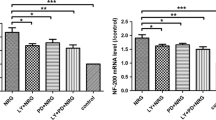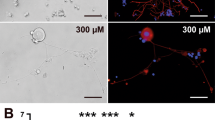Abstract
The effects of vascular factors on the nervous system are still poorly investigated. Angiopoietin-1 (Ang-1), an endothelial cell growth factor with influences on blood vessel stabilization, has been recently reported to prevent apoptosis in a neuroblastoma cell line via a pathway dependent on Tie-2 receptor. The present study focuses on the effect of Ang-1 on cultured dorsal root ganglion (DRG) cells isolated from 1-day-old rats. Three-day-old DRG cultures were exposed to Ang-1 treatment under serum-free condition for another 5 days and stained with antibodies against neurofilament (NF) 200 protein. Neurite length and density increased compared with those of controls. Double-immunofluorescence staining demonstrated the co-localization of the Tie-2 receptor in some NF-200-positive perikarya. The reverse transcription/polymerase chain reaction technique identified Tie-2 receptor mRNA in intact DRG and in Ang-1-stimulated DRG cell cultures, but not in a Schwann cell line or in primary astrocyte cultures. Western blotting confirmed that the expression of NF 68 protein in cultures treated with Ang-1 or nerve growth factor was higher than that in cultures treated with medium alone. When the Tie-2 receptor was blocked with anti-Tie-2 receptor antibody, neurite outgrowth was severely impeded. Induction of trkA-receptor protein expression was observed to be dependent on the presence of Tie-2 receptors. We conclude that Ang-1 promotes neurite outgrowth from DRG cells positive for Tie-2 receptor. The signalling pathway appears to involve transactivation of the trkA receptor.







Similar content being viewed by others
References
Acheson A, Conover JC, Fandl JP, DeChiara TM, Russell M, Thadani A, Squinto SP, Yancopoulus GD, Linsey RM (1995) A BDNF autocrine loop in adult sensory neurons prevents cell death. Nature 374:450–453
Acosta CG, Fabrega AR, Masco DH, Lopez HS (2001) A sensory neuron subpopulation with unique sequential survival dependence on nerve growth factor and basic fibroblast growth factor during development. J Neurosci 21:8873–8885
Baird A (1994) Fibroblast growth factors: activities and significance of non-neurotrophin neurotrophic growth factors. Curr Opin Neurobiol 4:78–86
Baudet Ch, Mikaels Ä, Westphal H, Johansen J, Johansen TE, Ernfors P (2000) Positive and negative interactions of GDNF, NTN, and ART in developing sensory neuron subpopulations, and their collaboration with neurotrophins. Development 127:4335–4344
Damon DH (1999) Endothelin and post-ganglionic sympathetic neurons. Clin Exp Pharmacol Physiol 26:1000–1003
Edstrom A, Ekstrom PA (2003) Role of phosphatidylinosytol 3-kinase in neuronal survival an axonal outgrowth of adult mouse dorsal root ganglia explant. J Neurosci Res 75:726–735
Ernfors P, Kucera J, Lee KF, Loring J, Jeanisch R (1995) Studies on the physiological role of brain-derived neurotophic factor and neurotrophin-3 in knockout mice. Int J Dev Biol 39:799–807
Franke B, Figiel M, Engele J (1998) CNS glia are targets for GDNF and neurturin. Histochem Cell Biol 110:595–601
Friedman WJ, Greene LA (1999) Neurotrophin signaling via Trks and p75. Exp Cell Res 253:131–142
Fujikawa K, Aos Scherpenseel I de, Jain SK, Presman E, Christensen RA, Varticovski L (1999) Role of PI 3-kinase in angiopoietin-1-mediated migration and attachment-dependent survival of endothelial cells. Exp Cell Res 253:663–672
Gschwendtner A, Liu ZQ, Hucho T, Bohatschek M, Kalla R, Dechant G, Raivich G (2003) Regulation, cellular localization, and function of the p75 neurotrophin receptor (p75NTR) during the regeneration of facial motoneurons. Mol Cell Neurosci 24:307–322
Kaplan DR, Miller FD (2000) Neurotrophin signal transduction in the nervous system. Curr Opin Neurobiol 10:381–391
Kerkes N, Landry M, Lundmark K, Hökfelt T (1994) Effect of NGF, BDNF, bFGF, aFGF and cell density on NPY expression in cultured rat dorsal root ganglion neurones. J Autonom Nerv Syst 81:128–138
Kuroda H, Ohtsuru A, Futakuchi M, Kawashita Y, Nagayama Y, Fukuda E, Namba H, Shirai T, Kanematsu T, Yamashita S (2002) Distinctive gene expression of receptor-type tyrosine kinase families during rat hepatocarcinogenesis. Int J Mol Med 9:473–480
Lee FS, Rajagopal R, Chao MV (2002) Distinctive features of Trk neurotrophin receptor transactivation by G protein-coupled receptors. Cytokine Growth Factor Rev 13:11–17
Levi-Montalcini R (1987) The nerve growth factor thirty-five years later. EMBO J 6:1145–1154
Lin T-N, Nian G-M, Chen S-F, Cheung W-M, Chang C, Lin W-C (2001) Induction of Tie-1 and Tie-2 receptor protein expression after cerebral ischemia-reperfusion. J Cerebr Blood Flow Metab 21:690–701
Minichiello L, Piehl F, Vazquez E, Schimmang T, Hökfelt T, Represa J, Klein R (1995) Differential effects of combined trk receptor mutations on dorsal root ganglion and inner ear sensory neurons. Development 121:4067–4075
Mompéo B, Engele J, Spanel-Borowski K (2003) Endothelial cell influence on dorsal root ganglion cell formation. J Neurocytol 32:123–129
Pannese E (1974) The histogenesis of the spinal ganglia. Anat Embryol 47:7–97
Poncet S, Gasc J-M, Janzer RC, Meyer S, Juillerat-Jeanneret L (2003) Expression of Tie-2 in human peripheral and autonomic nervous system. Neuropath Appl Neuro 29:361–369
Risau W (1997) Mechanisms of angiogenesis. Nature 386:671–674
Shahrara S, Volin MV, Connors MA, Haines GK, Koch AE (2002) Differential expression of the angiogenic Tie receptor family in arthritic and normal synovial tissue. Arthritis Res 4:201–208
Sondell M, Lundborg G, Kanje M (1999a) Vascular endothelial growth factor has neurotrophic activity and stimulates axonal outgrowth, enhancing cell survival and Schwann cell proliferation in the peripheral nervous system. J Neurosci 19:5731–5740
Sondell M, Lundborg G, Kanje M (1999b) Vascular endothelial growth factor stimulates Schwann cell invasion and neovascularization of acellular nerve grafts. Brain Res 846:219–228
Song X-Y, Zhong J-H, Wang X, Zhou X-F (2004) Suppression of p75NTR does not promote regeneration of injured spinal cord in mice. J Neurosci 24:542–546
Suri C, Jones PF, Patan S, Bartunkova S, Maisonpierre PC, Davis S, Sato TN, Yancopoulos GD (1996) Requisite role of angiopioetin-1, a ligand for TIE2 receptor, during embryonic angiogenesis. Cell 87:1171–1180
Suri C, McClain J, Thurston G, McDonald DM, Zhou H, Oldmixon EH, Sato TN, Yancopoulos GD (1998) Increased vascularization in mice overexpressing angiopoietin-1. Science 282:468–471
Takakura N, Watanabe T, Suenobu S, Yamada Y, Noda T, Satake M, Suda T (2000) A role for hematopoietic stem cells in promoting angiogenesis. Cell 102:199–209
Thurston G (2003) Role of angiopoietins and Tie receptor tyrosine kinases in angiogenesis and lymphangiogenesis. Cell Tissue Res 314:61–68
Valable S, Bellail A, Lesne S, Liot G, MacKenzie ET, Vivien D, Bernaudin M, Petit E (2003) Angiopoietin-1-induced phosphatidyl-inositol-3-kinase activation prevents neuronal apoptosis. FASEB J 17:443–445
Velazquez OC, Snyder R, Liu Z-J, Fairman RM, Herlyn M (2002) Fibroblast-dependent differentiation of human microvascular endothelial cells into capillary-like 3-dimensional networks. FASEB J 16:1316–1318
Yancopoulos GD, Davis S, Gale NW, Rudge JS, Wiegand SJ, Holash J (2000) Vascular-specific growth factors and blood vessel formation. Nature 407:242–248
Acknowledgements
We deeply appreciate the technical skills of Claudia Merkwitz. This study was financially supported by the Deutsche Forschungsgemeinschaft, DFG, project no. Sp 232/7-1.
Author information
Authors and Affiliations
Corresponding author
Additional information
This study was financially supported by the Deutsche Forschungsgemeinschaft (DFG), project no. Sp 232/7-1.
Rights and permissions
About this article
Cite this article
Kosacka, J., Figiel, M., Engele, J. et al. Angiopoietin-1 promotes neurite outgrowth from dorsal root ganglion cells positive for Tie-2 receptor. Cell Tissue Res 320, 11–19 (2005). https://doi.org/10.1007/s00441-004-1068-2
Received:
Accepted:
Published:
Issue Date:
DOI: https://doi.org/10.1007/s00441-004-1068-2




